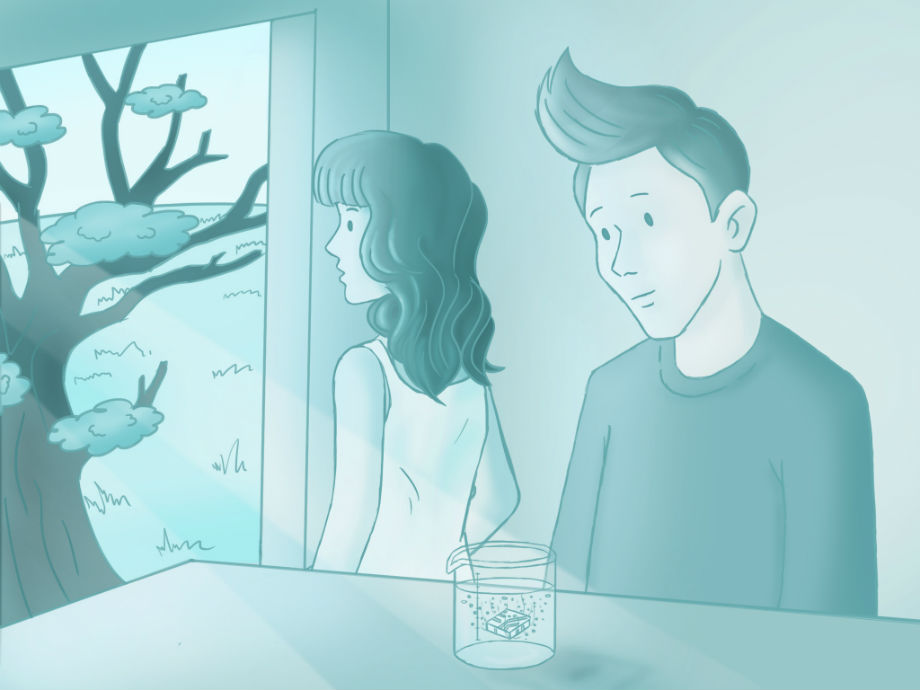Artificial Photosynthesis

After wandering around downtown Amsterdam, taking photos of the famous picturesque canals, Max and Lily headed to the, also world famous, University of Amsterdam. As part of their solar energy initiative, they were working on artificial photosynthesis.
They both felt that there was no better way of ending their journey than getting to know something more about this valuable project, creating a process to imitate nature’s way of producing energy for billions of years, to produce energy for modern civilisation’s needs.
“We use energy for many things, but there are three basic requirements” Lily started. “For heating, electricity production, and transport. Artificial photosynthesis will help with the latter two”.
Max however, couldn’t help but feel a little disappointed. He held at eye level a beaker containing a photocatalytic cell in water. There were lots of tiny bubbles rising up. “This is the artificial leaf?” he asked reading the label. “I expected something… greener” he complained.
“Like what?” Lily asked. “It may not be green in colour, but it works by the same principle as a leaf” she continued. “Do you even know what photosynthesis is?” she teased.
Max said he knew perfectly well what photosynthesis is. Plants absorb solar energy and convert it into chemical energy. They combine the carbon dioxide they capture from the atmosphere with water to create their food, glucose, and oxygen.
“Glucose is a carbohydrate” Lily added. “And this artificial leaf you are holding there does something similar. It uses solar energy to split water into oxygen and hydrogen. Do you see the bubbles? Those are oxygen and hydrogen. Oxygen is coming from the front side of the leaf and hydrogen from the back. Hydrogen is used as a fuel".
While in nature the “usable fuel" is carbohydrates, proteins and fats, in this case scientists were looking for fuel to power cars and electricity to run devices. Artificial Photosynthesis is the process of preparing fuels from nothing more than water, sunlight and carbon dioxide. It is a vital process, the foundation of a world that no longer needs fossil fuels. By combining carbon dioxide with water, artificial photosynthesis produces hydrocarbons. Made of hydrogen and carbon, hydrocarbons like propane and octane are the basic components of gasoline and natural gas, and have been used for centuries as fuels. This type of artificial photosynthesis also has the advantage of reducing the carbon dioxide in our atmosphere.
“But how is it done?” Max wondered loudly. Lily said there was one word that explains it all: catalysts. A catalyst is a material that speeds up a chemical reaction. New catalysts have been developed in order to enable artificial photosynthesis.
When these catalysts are coupled with materials that absorb light, the efficient production of fuels such as methanol becomes possible. At the beginning, precious metals like platinum or iridium were used as catalysts. They were very pricey however, so new, cheaper, alternatives had to be developed. For example, one catalyst that is harmless, environmentally friendly, and also very stable, is titanium dioxide. In addition, some metal alloys have proven to be efficient catalysts. One in particular, a nickel molybdenum zinc alloy (NiMoZn), is very efficient for hydrogen production.
Both Max and Lily were impressed by the achievement. It may not look like a leaf, but acts like it. Artificial photosynthesis reduces atmospheric carbon dioxide, providing fresher air, while creating fuels to power both cars and electric devices. Efficiency, caring for the environment, sustainability: the path for a new world, a better world, was being shaped.
